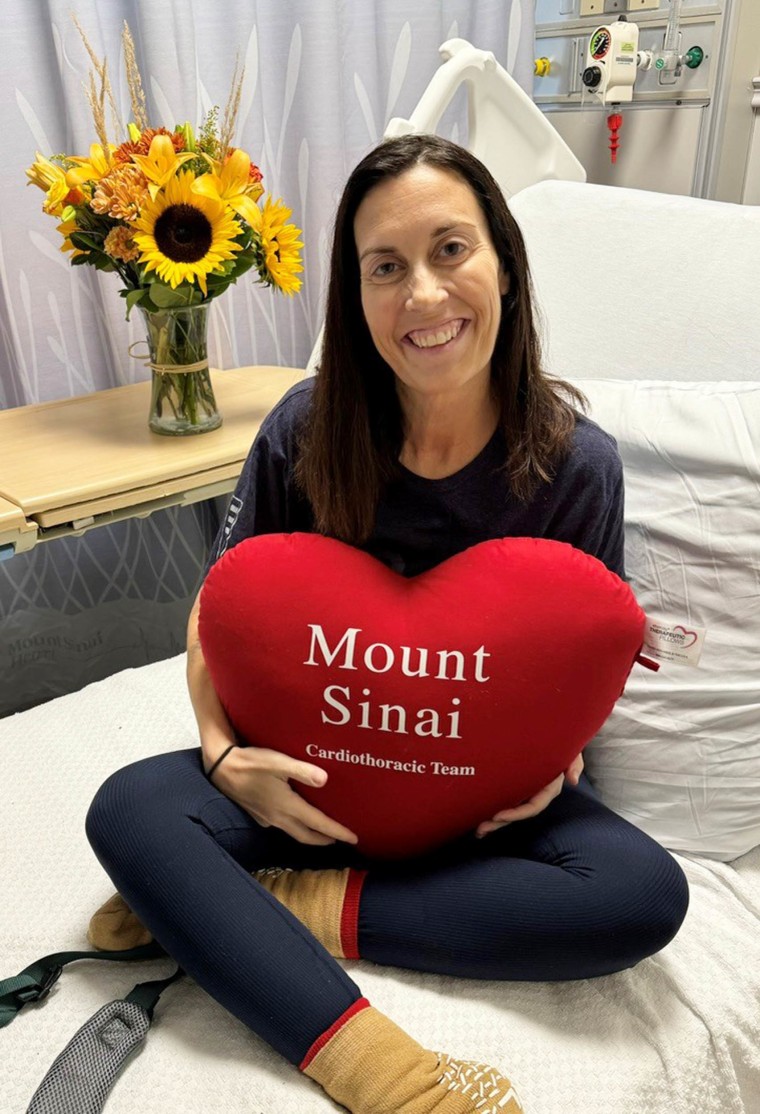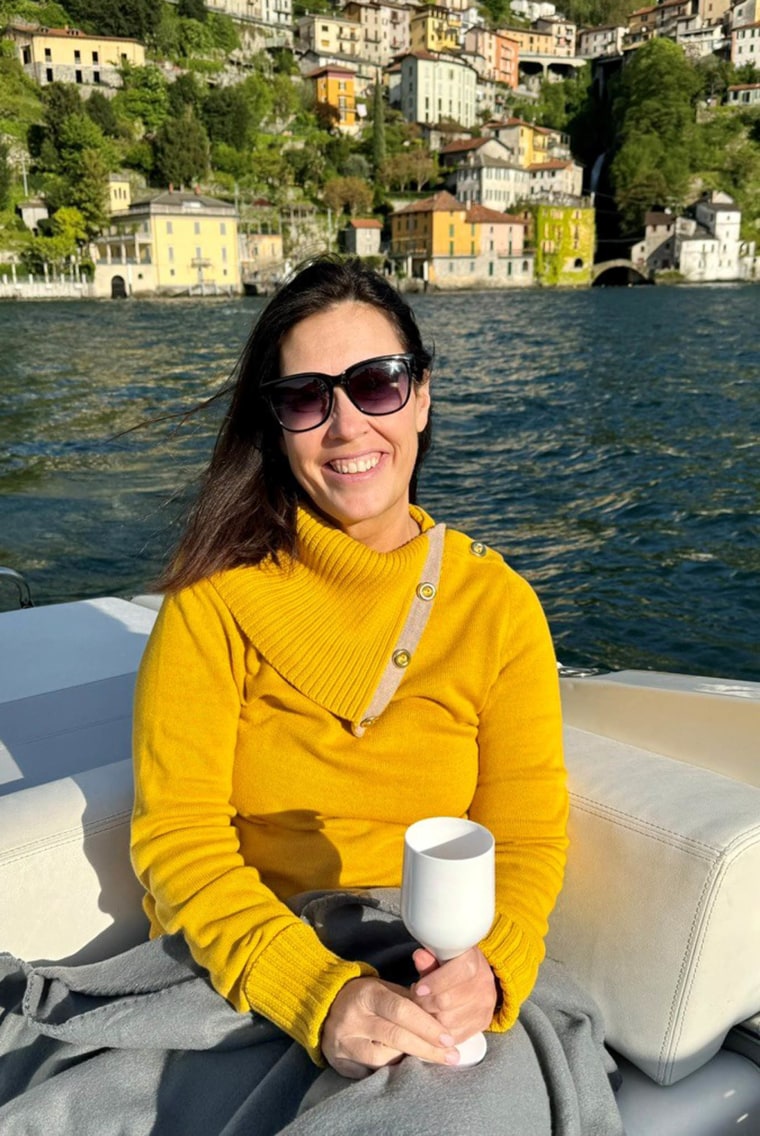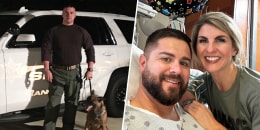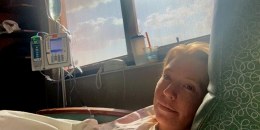Sue Dumbauld was stressed. Work was overwhelming which led to poor eating habits, lack of sleep and infrequent exercise. During a call, she heard the shrill alarm of her Apple Watch and thought it was an Amber Alert. When she glanced at it, she was surprised.
“It says, ‘Your heart rate is at 137 for more than 10 minutes, do you want to call 911?’” Dumbauld, 48, of Atlanta, tells TODAY.com. “I didn’t even know I had that on my Apple Watch.”
Soon after, she quit her job to focus on her health. Dumbauld was born with a congenital heart condition, aortic stenosis, and over the years she underwent numerous open-heart surgeries. The Apple Watch was the first indication that Dumbauld would need yet another intervention. But first, she tried doing what she could to bolster her health.
“I completely changed my eating habits. I walked an hour every single day. I do Barre workouts,” she says. “Within six months, I had lowered my LDL cholesterol by 49 points. I had lost weight. I felt better than I had in years. And really looking back at it, my recovery for my fourth heart operation … I was in the best shape of my life.”
A history of heart problems
Dumbauld was born with aortic stenosis, a condition in which the aorta is narrow or blocked, and she underwent surgery at only 4 days old. While she lived a “really normal life” growing up, at 18 she developed endocarditis, an infection in her heart.

“They realized that I would need another open-heart surgery,” she says. “In that open heart surgery, they replaced my aortic valve, and they put a patch on my mitral valve to fix where my heart was impacted by that infection.” After recovery, life again became “normal,” and when she graduated from college she moved to Atlanta.
“I got the travel bug,” she says. “I’ve been to all seven continents and 50-plus countries and have been living a great life.”
In 2014, when she underwent her routine echocardiogram, it showed her aortic valve had deteriorated and needed to be replaced. Doctors wondered if she wanted a mechanical valve or a tissue valve. Each one comes with a drawback. People who receive mechanical valves need to take blood thinners for the rest of their lives. Patients receiving a tissue valve do not need to take blood thinners, but these valves do not last as long.
“You really have to make a choice of lifestyle or longevity,” Dumbauld says. “For me, lifestyle was the most important thing at that time. So, I chose a tissue valve.”
For the next decade, Dumbauld enjoyed life with few restrictions. After the Apple Watch alert, she realized she would need to have her valve replaced sooner rather than later. She quit her job in April 2023 and started her new healthy habits and noticed big differences. But then she underwent an echocardiogram in June 2024 that “showed irregularities.”
“I went from zip-lining in Costa Rica the week before to being admitted to the hospital for additional testing and realizing I was going to have to have a fourth open surgery,” she says.
In fact, when she was admitted to the hospital, she learned how sick she was. She had heart failure.
“I just thought I had more time than I did,” she says. “The first valve lasted 18 years so that’s what I was expecting — the second valve to last 18, 20 years.”
The upcoming surgery would be complicated with Dumbauld’s history and the extensive damage to her heart. She planned on having it completed at Mount Sinai Health System in New York City but couldn’t schedule it until September. Then her health worsened, and she experienced shortness of breath and chest pain. Her doctor advised her not to let her heart rate go above 100 beats per minute, which meant a lot of sitting.
“I went downhill pretty quickly in August, early September,” she says. “I was admitted five days prior just so I could be under their care in case anything happened before surgery.”
Doctors moved her surgery up by 12 days because Dumbauld’s condition deteriorated so much.
“Being my fourth open heart surgery, I think inherently makes it much more complex going in,” she says. “They anticipated it would be a six-and-a-half-hour surgery, and it ended up being a 10-hour surgery.”
Fixing a heart
Dumbauld underwent a Ross procedure with a mitral valve and tricuspid valve repair, an extensive and complex surgery, Dr. Ismail El-Hamamsy says.
“The Ross procedure is basically an operation where we replaced the patient’s diseased aortic valve with their own pulmonary valve,” the director of aortic surgery for the Mount Sinai Health System in New York City tells TODAY.com. “The pulmonary valve is basically a mirror image of a normal aortic valve.”
When moved, it takes over the role of the aortic valve, “which is the most important one in the heart,” he says. This is better than using another tissue or mechanical valve.
“When you look at outcomes in the long term for patients, patients do a lot better from a life expectancy standpoint, from a durability … standpoint, from a quality of life standpoint,” El-Hamamsy says.

Then he replaced the pulmonary valve with a cadaver valve.
“The idea behind the Ross is that you’re putting your ‘best player’ in the aortic position,” he says. “Then you’re putting something that is not the patient’s own in apposition where the pressures are lower, the stresses are lower.”
While Dumbauld needed to undergo the Ross procedure, she also needed to have her mitral valve and tricuspid valve repaired. This meant that doctors replaced or repaired all four of Dumbauld’s heart valves.
“We’re basically reconstructing her mitral valve,” Dr. David Adams, chair of cardiovascular surgery at Mount Sinai Health System, tells TODAY.com. “We repaired (the tricuspid) valve.”
Performing these procedures meant that Dumbauld didn’t need a mechanical valve “that requires blood thinners for the rest of her life,” Adams says.
“It gives her the best chance at event-free survival and minimizes her risk for (bleeding) in the future,” he says. “This is such an amazing operation.”
The surgery allows Dumbauld to resume her exercises and travel without worry and without the need to put patients on medication for a lifetime.
“That’s the beauty of reconstructive valve surgery,” Adams says. “In the long term, these patients go about their normal life.”
Undergoing this more complicated surgery means young patients might not need future subsequent valve replacement procedures.
“They’re still very active, they still have a long anticipated life expectancy and therefore they stand to benefit,” El-Hamamsy says. “You avoid this need for multiple re-operations every decade or so.”
Packing her bags again
After Dumbauld left the hospital following surgery, she remained in New York City for a few weeks. Slowly, she rebuilt her strength, first walking down the block and gradually building up the distances she could handle.
“I did multiple walks a day,” she says. “We were two blocks from Central Park.”
After being released from their care, she spent some time at her parents' house in Hershey, Pennsylvania to continue her recovery.
“You have arm exercises to help with the stiffness in your chest,” she says.
After about four months, she started to feel like herself again.
“It’s definitely been a road of ups and downs and highs and lows,” she says. “I’m definitely on the right path.”

In December, less than three months after her surgery, Dumbauld visited Austria and Germany to see the Christmas markets. She’s booked trips for the winter and spring of 2025 and plans on searching for a new job.
“I still have the travel bug in me so in whatever my next role is I have to make sure I’m balancing work and personal,” she says. “(I need) to make sure I can go out and explore the world.”









